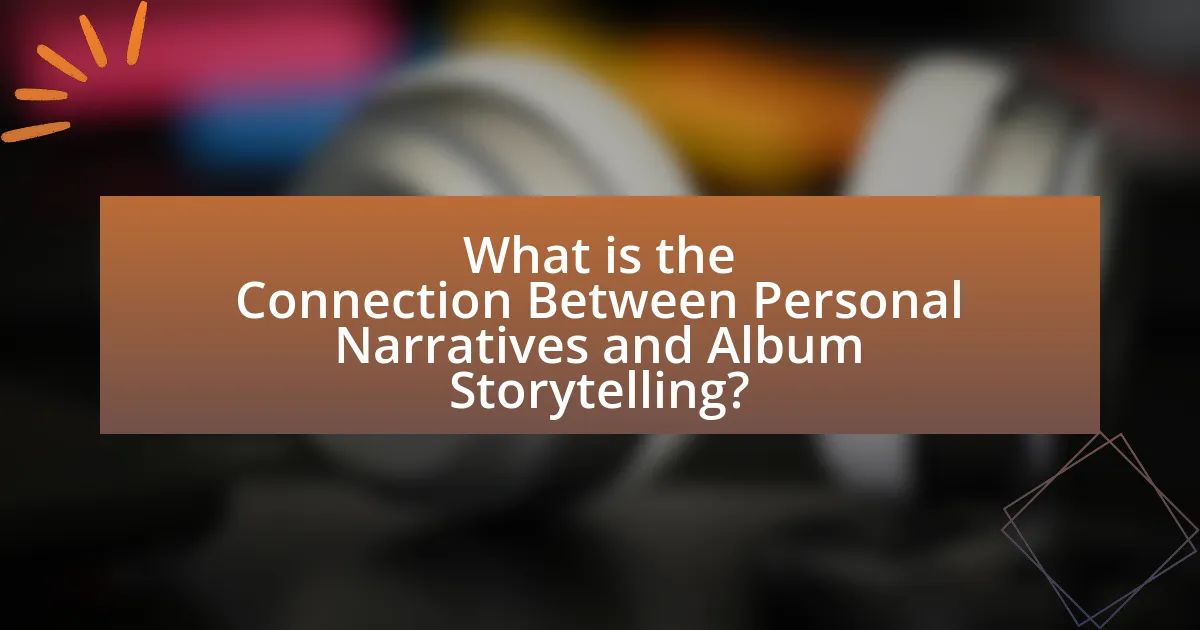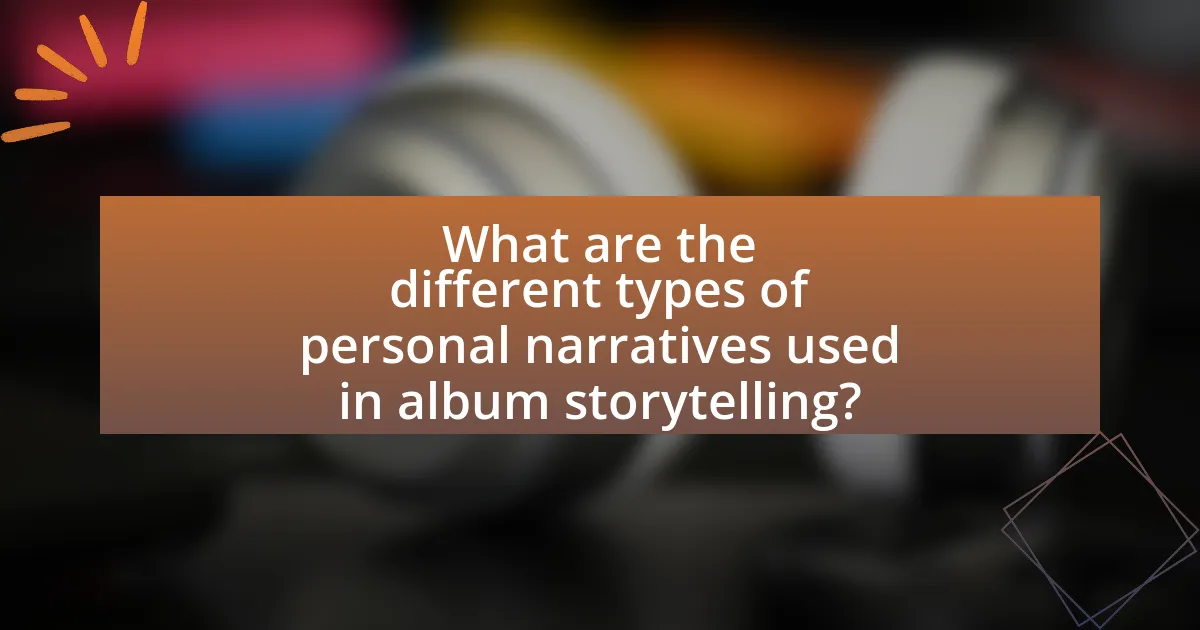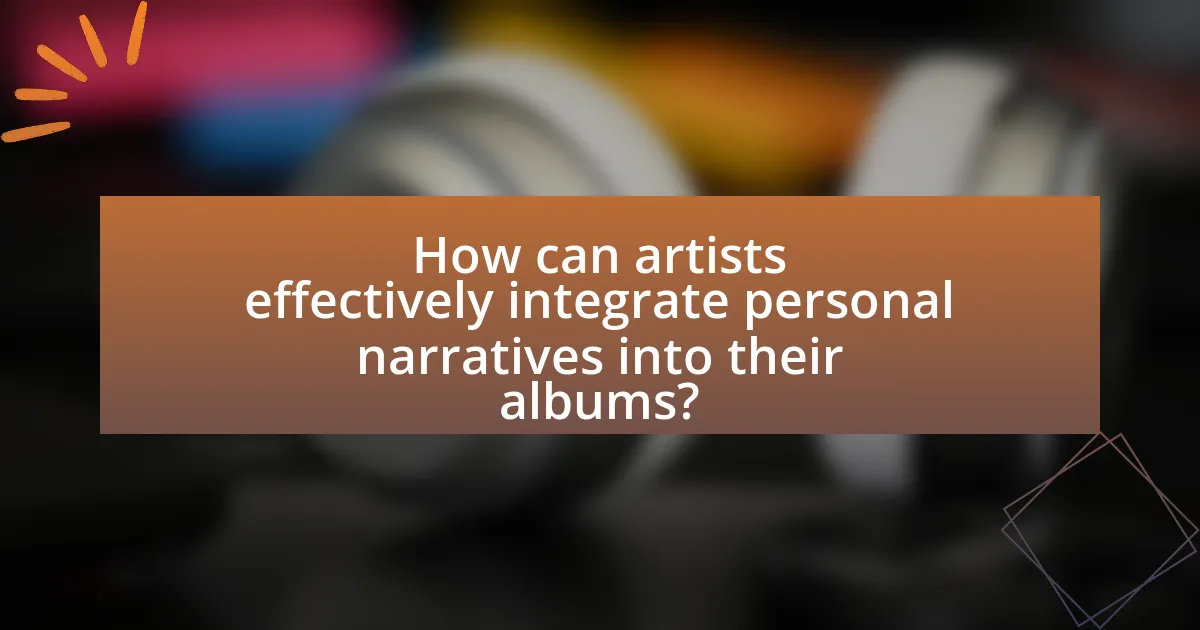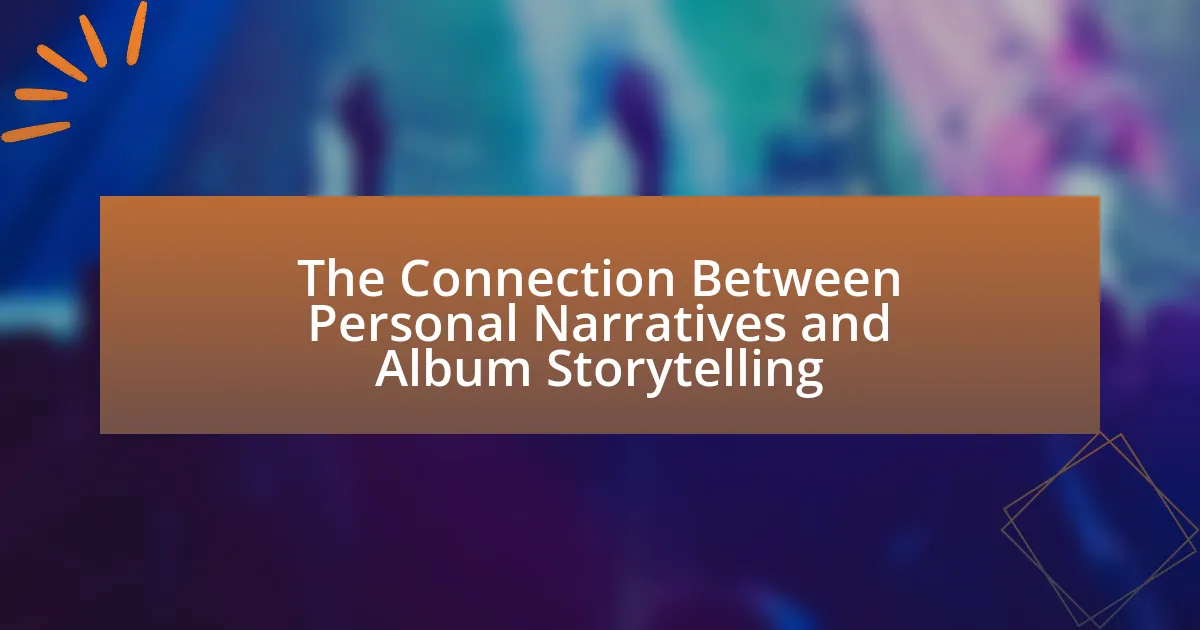The article explores the connection between personal narratives and album storytelling, highlighting how artists utilize their life experiences to create relatable and emotionally resonant music. It examines the influence of personal narratives on album structure, including elements such as character development, emotional arcs, and thematic coherence. The discussion includes the importance of storytelling in music, the role of emotional connection, and various narrative types, such as autobiographical and fictional narratives. Additionally, it addresses best practices for artists in crafting narrative-driven albums while balancing personal storytelling with broader audience appeal, and identifies common pitfalls to avoid in the storytelling process.

What is the Connection Between Personal Narratives and Album Storytelling?
Personal narratives and album storytelling are interconnected through their shared use of individual experiences to convey emotions and themes. Both mediums rely on the authenticity of personal experiences to create relatable content that resonates with audiences. For instance, artists often draw from their own life stories, struggles, and triumphs to craft songs that form a cohesive narrative throughout an album. This approach not only enhances the emotional depth of the music but also allows listeners to connect on a personal level, as evidenced by albums like Taylor Swift’s “Folklore,” which intricately weaves personal anecdotes into its storytelling. Thus, the connection lies in the ability of both personal narratives and album storytelling to transform individual experiences into universal themes, fostering empathy and understanding among listeners.
How do personal narratives influence album storytelling?
Personal narratives significantly influence album storytelling by providing authentic emotional depth and relatability. Artists often draw from their own life experiences, struggles, and triumphs to craft songs that resonate with listeners on a personal level. For instance, Taylor Swift’s albums frequently reflect her personal relationships and life events, allowing fans to connect deeply with her music. This connection is supported by research indicating that autobiographical elements in music enhance listener engagement and emotional response, as seen in studies published in the Journal of Music Psychology. Thus, personal narratives serve as a foundational element in creating compelling and relatable album storytelling.
What elements of personal narratives are commonly found in album storytelling?
Album storytelling commonly incorporates elements such as character development, emotional arcs, and thematic coherence found in personal narratives. Character development allows listeners to connect with the artist’s experiences, while emotional arcs provide a journey that resonates on a personal level. Thematic coherence ensures that the album conveys a unified message or story, similar to how personal narratives maintain focus on a central theme. These elements enhance the listener’s engagement and understanding, making the storytelling more impactful and relatable.
How do artists use their life experiences to shape their albums?
Artists use their life experiences to shape their albums by drawing on personal narratives that reflect their emotions, struggles, and triumphs. This process allows them to create authentic and relatable music that resonates with listeners. For example, Taylor Swift often incorporates her relationships and personal growth into her lyrics, which has led to widespread acclaim and connection with her audience. Similarly, Kendrick Lamar’s albums frequently explore themes of identity and social issues rooted in his upbringing, providing a powerful commentary on his life experiences. These examples illustrate how artists transform their individual stories into compelling musical narratives, enhancing the emotional depth and storytelling of their albums.
Why is storytelling important in music albums?
Storytelling is important in music albums because it creates a cohesive narrative that enhances the listener’s emotional connection to the music. This narrative structure allows artists to convey complex themes and personal experiences, making the album more relatable and impactful. For instance, concept albums like Pink Floyd’s “The Wall” illustrate how storytelling can explore deep psychological themes, engaging listeners on multiple levels. By weaving personal narratives into their work, musicians can evoke empathy and foster a sense of shared experience, which is crucial for audience engagement and retention.
What role does emotional connection play in album storytelling?
Emotional connection is crucial in album storytelling as it enhances listener engagement and fosters a deeper understanding of the narrative. When artists convey personal experiences and emotions through their music, listeners are more likely to relate to the themes presented, creating a shared emotional journey. Research indicates that emotionally charged music can activate brain regions associated with reward and empathy, suggesting that emotional resonance in storytelling can lead to a more impactful listening experience. For example, albums like “The Miseducation of Lauryn Hill” utilize personal narratives that evoke strong feelings, allowing listeners to connect with the artist’s experiences on a profound level. This connection not only enriches the storytelling but also solidifies the album’s place in the listener’s memory.
How does narrative structure enhance the listening experience?
Narrative structure enhances the listening experience by providing a coherent framework that guides the audience through a story, making it more engaging and relatable. This structured approach allows listeners to follow character development, plot progression, and thematic elements, which fosters emotional connections and deeper understanding. Research indicates that stories with clear narrative structures, such as those found in albums, can evoke stronger emotional responses, as listeners are able to anticipate and reflect on the unfolding events, thereby increasing their overall enjoyment and retention of the material.

What are the different types of personal narratives used in album storytelling?
Different types of personal narratives used in album storytelling include chronological narratives, thematic narratives, and reflective narratives. Chronological narratives present events in the order they occurred, allowing listeners to follow a linear progression of experiences. Thematic narratives focus on specific themes or emotions, weaving together various experiences that relate to a central idea, which can evoke deeper connections with the audience. Reflective narratives involve introspection, where the artist shares insights and lessons learned from their experiences, often providing a more profound understanding of their journey. These narrative types enhance the storytelling aspect of albums, making them relatable and impactful for listeners.
How do autobiographical narratives differ from fictional narratives in albums?
Autobiographical narratives in albums are based on real-life experiences and personal truths, while fictional narratives are created from imagination and do not necessarily reflect reality. Autobiographical narratives often include specific details, emotions, and events from the artist’s life, providing authenticity and relatability to listeners. In contrast, fictional narratives allow artists to explore themes and stories that may not be tied to their own experiences, offering creative freedom and imaginative storytelling. This distinction is evident in albums where autobiographical songs often resonate deeply with audiences due to their genuine nature, whereas fictional songs can engage listeners through inventive plots and characters.
What are examples of autobiographical albums that showcase personal narratives?
Examples of autobiographical albums that showcase personal narratives include “The College Dropout” by Kanye West, which reflects his struggles and aspirations, and “Born to Run” by Bruce Springsteen, which narrates his experiences growing up in New Jersey. Additionally, “Lemonade” by Beyoncé explores themes of infidelity and empowerment, while “American Idiot” by Green Day addresses political disillusionment and personal identity. Each of these albums incorporates storytelling elements that provide insight into the artists’ lives and perspectives, making them significant examples of autobiographical storytelling in music.
How do fictional narratives create a different impact in album storytelling?
Fictional narratives create a different impact in album storytelling by allowing artists to explore themes and emotions in a more imaginative and abstract manner. This approach enables the artist to construct complex characters and scenarios that resonate with listeners on a symbolic level, often evoking deeper emotional responses than personal narratives might achieve. For instance, albums like “The Wall” by Pink Floyd utilize fictional elements to address universal themes of isolation and alienation, making the storytelling more relatable to a broader audience. This technique can enhance the listener’s engagement, as they may find themselves reflecting on their own experiences through the lens of the fictional narrative presented in the album.
What themes are commonly explored through personal narratives in albums?
Common themes explored through personal narratives in albums include love, loss, identity, and resilience. These themes often reflect the artist’s personal experiences and emotions, allowing listeners to connect on a deeper level. For instance, albums like Taylor Swift’s “Folklore” delve into storytelling about heartbreak and self-discovery, while Kendrick Lamar’s “good kid, m.A.A.d city” addresses themes of struggle and redemption in the context of his upbringing. Such thematic exploration not only enhances the emotional impact of the music but also fosters a sense of relatability and authenticity, making the narratives resonate with a wide audience.
How do themes of love and loss manifest in album storytelling?
Themes of love and loss manifest in album storytelling through lyrical content, emotional tone, and narrative arcs that reflect personal experiences. Artists often use specific songs to explore relationships, heartbreak, and the impact of loss, creating a cohesive narrative that resonates with listeners. For instance, albums like Adele’s “21” and Bon Iver’s “For Emma, Forever Ago” illustrate these themes by detailing personal struggles and emotional journeys, allowing audiences to connect deeply with the stories being told. The use of vivid imagery and relatable emotions in the lyrics serves to enhance the storytelling, making the themes of love and loss not only central to the narrative but also universally relatable.
What other themes are prevalent in personal narratives within music albums?
Common themes in personal narratives within music albums include love, loss, identity, and resilience. Love often explores romantic relationships and emotional connections, while loss addresses grief and the impact of separation. Identity themes delve into self-discovery and personal growth, reflecting the artist’s journey. Resilience highlights overcoming challenges and adversity, showcasing strength and perseverance. These themes resonate with listeners, creating a relatable and emotional experience, as evidenced by numerous successful albums that center around these concepts, such as Adele’s exploration of heartbreak and Taylor Swift’s narratives on personal growth and identity.

How can artists effectively integrate personal narratives into their albums?
Artists can effectively integrate personal narratives into their albums by using storytelling techniques that reflect their life experiences and emotions. This can be achieved through songwriting that incorporates specific events, feelings, and reflections, allowing listeners to connect with the artist on a deeper level. For instance, artists like Taylor Swift and Eminem have successfully woven their personal stories into their music, creating relatable content that resonates with audiences. Swift’s album “Folklore” features detailed narratives about her relationships and personal growth, while Eminem’s “The Marshall Mathers LP” includes autobiographical elements that explore his struggles and triumphs. By grounding their work in authenticity and vulnerability, artists can create a compelling narrative arc that enhances the overall impact of their albums.
What techniques can artists use to convey their personal stories in music?
Artists can convey their personal stories in music through techniques such as lyrical storytelling, emotional instrumentation, and vocal delivery. Lyrical storytelling allows artists to articulate their experiences and emotions directly, often using vivid imagery and relatable themes to engage listeners. Emotional instrumentation, including the choice of instruments and musical arrangements, enhances the narrative by evoking specific feelings that align with the story being told. Vocal delivery, characterized by tone, pitch, and dynamics, further emphasizes the emotional weight of the lyrics, making the personal narrative more impactful. These techniques are evidenced by artists like Taylor Swift, who uses detailed lyrics and varied vocal styles to share her life experiences, creating a strong connection with her audience.
How does songwriting style affect the storytelling aspect of an album?
Songwriting style significantly influences the storytelling aspect of an album by shaping how narratives are conveyed and perceived. For instance, a narrative-driven songwriting style, characterized by detailed imagery and character development, allows listeners to engage deeply with the story, as seen in albums like “The Wall” by Pink Floyd, where each song contributes to a cohesive narrative arc. Conversely, a more abstract or fragmented songwriting style may lead to a less linear storytelling experience, as demonstrated in Radiohead’s “OK Computer,” where themes are explored through disjointed lyrics that evoke emotions rather than a clear storyline. This variation in songwriting style directly impacts the listener’s ability to connect with the album’s themes and characters, ultimately determining the effectiveness of the storytelling.
What role does instrumentation play in enhancing personal narratives?
Instrumentation plays a crucial role in enhancing personal narratives by providing emotional depth and context to the storytelling. The use of specific instruments can evoke particular feelings, create atmospheres, and underscore the themes present in the narrative. For instance, a soft piano melody can convey nostalgia, while a driving guitar riff may express urgency or passion. Research indicates that music can significantly influence emotional responses, as demonstrated in studies showing that certain musical elements can enhance memory recall and emotional engagement in storytelling. This connection between instrumentation and emotional resonance makes personal narratives more impactful and relatable to the audience.
What are some best practices for artists to follow when crafting narrative-driven albums?
Artists should focus on creating a cohesive storyline that resonates emotionally with listeners when crafting narrative-driven albums. This involves developing a central theme or concept that guides the album’s structure and lyrics, ensuring that each song contributes to the overall narrative arc. For instance, artists like Kendrick Lamar in “good kid, m.A.A.d city” effectively use personal experiences to create a compelling story that engages the audience. Additionally, incorporating interludes or skits can enhance the storytelling by providing context and depth, as seen in albums like “The Miseducation of Lauryn Hill.” Furthermore, maintaining a consistent tone and style throughout the album helps to unify the narrative, making it more impactful and memorable for the audience.
How can artists balance personal storytelling with broader audience appeal?
Artists can balance personal storytelling with broader audience appeal by crafting relatable narratives that resonate universally while incorporating unique personal experiences. This approach allows artists to maintain authenticity in their work, as seen in the music of Taylor Swift, who often draws from her life but frames her stories in ways that evoke shared emotions and experiences among listeners. By using universal themes such as love, loss, and resilience, artists can connect with a wider audience while still expressing their individual perspectives. This strategy is supported by research indicating that stories with both personal and universal elements tend to engage listeners more effectively, enhancing emotional connection and relatability.
What common pitfalls should artists avoid in album storytelling?
Artists should avoid the pitfalls of inconsistency, lack of clarity, and overcomplication in album storytelling. Inconsistency can confuse listeners, as a disjointed narrative fails to engage them effectively; for example, an album that shifts abruptly between themes without a cohesive thread can alienate the audience. Lack of clarity in the message can lead to misinterpretation, where listeners struggle to grasp the intended emotions or stories, diminishing the impact of the work. Overcomplication, such as excessive metaphor or convoluted lyrics, can obscure the narrative, making it difficult for listeners to connect with the artist’s personal experiences. These pitfalls can detract from the overall storytelling experience, ultimately hindering the emotional resonance that artists aim to achieve through their albums.
